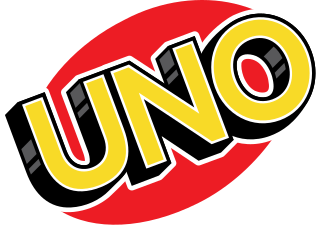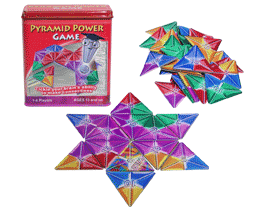
Mahjong or mah-jongg is a tile-based game that was developed in the 19th century in China and has spread throughout the world since the early 20th century. It is played by four players. The game and its regional variants are widely played throughout East and Southeast Asia and have also become popular in Western countries. The game has also been adapted into a widespread online entertainment. Similar to the Western card game rummy, mahjong is a game of skill, strategy, and luck. To distinguish it from mahjong solitaire, it is sometimes referred to as mahjong rummy.

Uno, stylized as UNO, is a proprietary American shedding-type card game originally developed in 1971 by Merle Robbins in Reading, Ohio, a suburb of Cincinnati, that housed International Games Inc., a gaming company acquired by Mattel on January 23, 1992.

Triominoes is a variant of dominoes using triangular tiles published in 1965. A popular version of this game is marketed as Tri-Ominos by the Pressman Toy Corp.

500 rum, also called pinochle rummy, Michigan rummy, Persian rummy, rummy 500 or 500 rummy, is a popular variant of rummy. The game of canasta and several other games are believed to have developed from this popular form of rummy. The distinctive feature of 500 rum is that each player scores the value of the sets or cards they meld. It may be played by 2 to 8 players, but it is best for 3 to 5.

Golf is a card game where players try to earn the lowest number of points over the course of nine deals.

Rummy is a group of games related by the feature of matching cards of the same rank or sequence and same suit. The basic goal in any form of rummy is to build melds which can be either sets or runs and either be first to go out or to amass more points than the opposition.

Alhambra is a 2003 tile-based German-style board game designed by Dirk Henn. It was originally published in Germany by Queen Games in a language-interdependent version; an English-specific version was released in North America by the now-defunct Überplay. The game is a Muslim-themed update, set during the construction of the Alhambra palace in 14th century Granada, of the 1998 stock trading board game Stimmt So!, which in turn was an update of the 1992 mafia influence board game Al Capone; the original version was subsequently released as Alhambra: The Card Game. Upon its release, Alhambra won numerous awards, including the Spiel des Jahres award. Its success has led to the release of numerous expansion packs and spin-off games, and is becoming Queen Games' flagship franchise.
Yaniv, also known as Jhyap, Jafar, aa’niv, Minca or Dave, is a card game popular in Israel. It is a draw and discard game in which players discard before drawing a new card and attempt to have the lowest value of cards in hand. The game is considered a backpackers game in Israel, and it's popular among soldiers and young adults returning from long backpacking trips.

Okey is a tile-based game. The aim of the game is to score points against the opposing players by collecting certain groups of tiles. Okey is usually played with four players, but can also be played with only two or three players. It bears resemblance to the game Rummikub, as it is played with the same set of boards and tiles, but under a different set of rules.

Chickenfoot or Chicken Foot, also called Chicken-Foot Dominoes and Chickie Dominoes, is a Block domino game of the "Trains" family for 2 to 12 players invented by Louis and Betty Howsley in 1986. Chicken Foot is played in rounds, one round for each double domino in the set and is best for 4 to 7 players.

Four color cards is a game of the rummy family of card games, with a relatively long history in southern China. In Vietnam the equivalent game is known as tứ sắc.
Go-Stop, also called Godori is a Korean fishing card game played with a Hwatu (Korean: 화투) deck. The game can be called Matgo (Korean: 맞고) when only two players are playing.

Pyramid Power is a tile game, where the goal is to score points by placing triangle-shaped tiles next to other triangle-shaped tiles so that the colors on the touching faces match. Doing so scores the player points. It was published by Winning Moves Games USA in 2008 and is one of three games in their Brain-Ade line of quick puzzle games and features both multiplayer and solitaire versions. This game is no longer in production.

Chinchón is a matching card game played in Spain, Uruguay, Argentina, Cape Verde and other places. It is a close variant of gin rummy, with which it shares the same objective: making sets, groups or runs, of matching cards.

Qwirkle is a tile-based game for two to four players, designed by Susan McKinley Ross and published by MindWare. Qwirkle shares some characteristics with the games Rummikub and Scrabble. It is distributed in Canada by game and puzzle company Outset Media. Qwirkle is considered by MindWare to be its most awarded game of all time. In 2011, Qwirkle won the Spiel des Jahres. A sequel, Qwirkle Cubes, was released by Mindware in 2009.
Buraco is a Rummy-type card game in the Canasta family for four players in fixed partnerships in which the aim is to lay down combinations in groups of cards of equal rank and suit sequences, there being a bonus for combinations of seven cards or more. Buraco is a variation of Canasta which allows both standard melds as well as sequences. It originated from Uruguay and Argentina in the mid-1940s, with apparent characteristics of simplicity and implications that are often unforeseeable and absolutely involving. Its name derives from the Portuguese word "buraco" which means “hole”, applied to the minus score of any of the two partnerships. The game is also popular in the Arab world, specifically in the Persian Gulf; where it is known as 'Baraziliya' (Brazilian). Another popular variation of Buraco is Italian.
Japanese mahjong, also known as riichi mahjong, is a variation of mahjong. While the basic rules to the game are retained, the variation features a unique set of rules such as riichi and the use of dora. The variant is one of a few styles where discarded tiles are ordered rather than placed in a disorganized pile. This is primarily due to the furiten rule, which takes player discards into account. The variant has grown popularity due to anime, manga, and online platforms.

Three-player mahjong is a variation of mahjong for three players rather than the more common four-player variations. It is not a mere adaption of four-player mahjong to suit only three players but has its own rules and idiosyncrasies that place it apart from the more standard variations. The equipment used and the basic mechanisms are much like four-player variations though some tiles are removed, certain plays are prohibited and the scoring system is simplified. The game is embraced in some Asian countries while ignored or snubbed in others.

Cabo is a 2010 card game by Melissa Limes and Mandy Henning that involves memory and manipulation based on the classic Golf card game and similar to Rat-a-Tat Cat (1995). The game uses a dedicated deck of cards with each suit numbered from 0 to 13, and certain numbers being marked as "Peek", "Spy" or "Swap". The objective of the game is for each player to minimize the sum of their own cards, four of which are played face-down to the table at the start of a round. Face-down cards may be revealed and swapped by card effects.
Le Trioker is an corner-matching puzzle game played using 25 equilateral triangle-shaped tiles. Each corner is marked with zero, one, two, or three dots and newly placed pieces must match the values on pieces already placed on the game board, similar to the gameplay of the earlier Triominoes.






















































